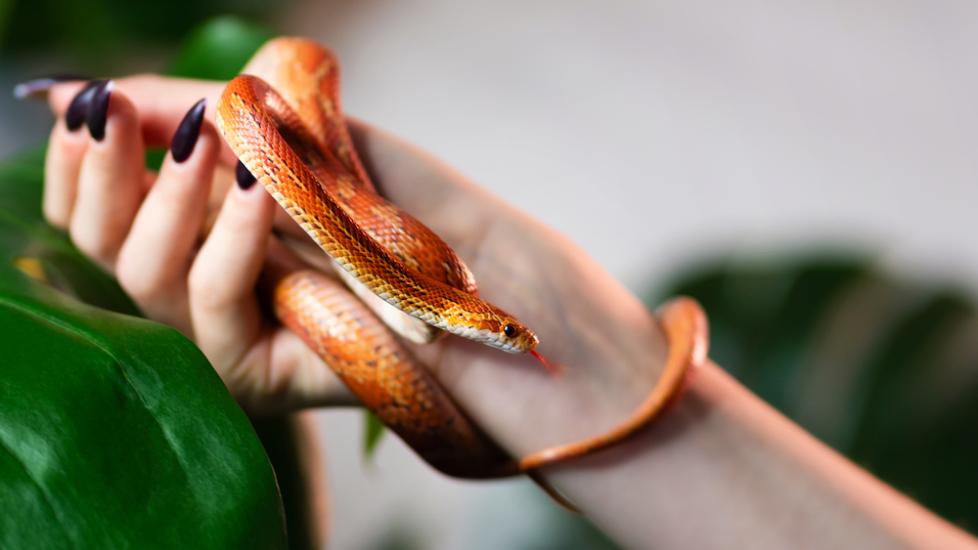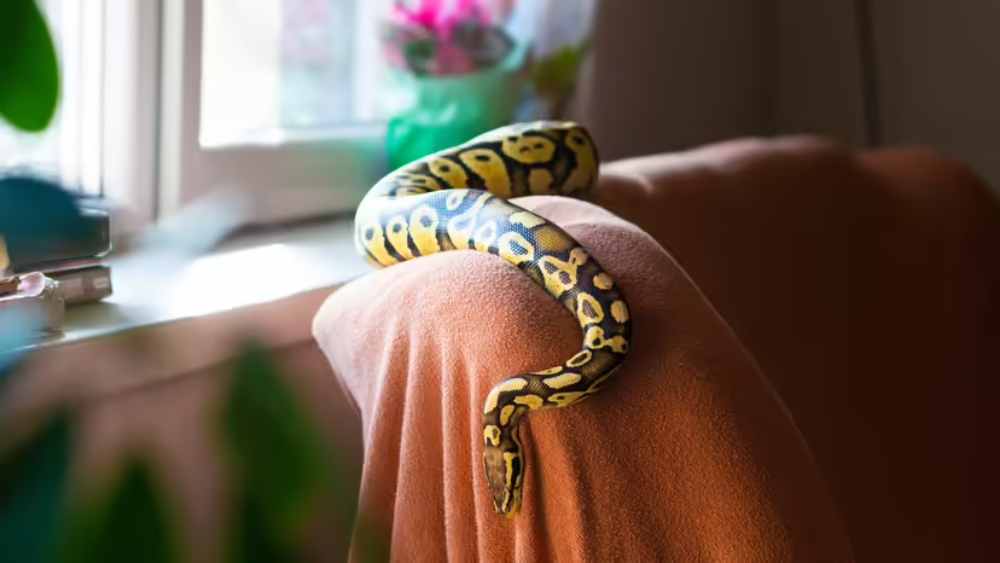
How to Care for a Pet Snake: A Beginner’s Guide
Snakes are fascinating and mysterious creatures that can make unique and rewarding pets. They have captured many people’s imaginations. Their grace, beauty, and unique traits make them special. Caring for a snake needs you to know its specific needs and plan carefully. If you want a pet snake, you need to create a safe and healthy home for it. This guide helps you pick the best snake species for beginners. It covers habitat setup, feeding, and common mistakes to avoid.

Quick Guide
- Select the Right Snake: Pick a calm and easy-to-care-for species. Good choices include the corn snake, ball python, or garter snake.
- Set Up the Enclosure: Choose an appropriately sized enclosure with a warm side (85-90°F) and a cool side (75-80°F). Maintain humidity levels between 40-60%, depending on your snake’s species.
- Provide Hiding Spots: Ensure your snake has several hiding spots within the enclosure to help it feel secure.
- Feed Properly: Feed your snake appropriately sized rodents. Establish a feeding schedule that suits the snake’s age (weekly for juveniles, bi-weekly for adults).
- Monitor Health: Regularly check your snake for signs of illness, changes in behaviour, or abnormal shedding.
Key Benefits of Owning a Pet Snake
Before we dive into the specifics of snake care, let’s explore the benefits of owning a pet snake. Understanding these can help you appreciate why they make such excellent pets.
- Low Maintenance: Compared to traditional pets like dogs or cats, snakes require minimal attention. They don’t need daily walks, grooming, or constant care. This makes them ideal for individuals with busy schedules or people who live in smaller spaces.
- Long Lifespan: Snakes can live for many years. Some species can live anywhere from 10 to 20 years with proper care. This longevity offers owners a long-term companion, creating a deeper bond over time.
- Hypoallergenic: Snakes are hypoallergenic. This makes them an excellent choice for people who suffer from allergies to pet dander or fur.
- Space-Efficient: Snakes are low-maintenance in terms of space. Their enclosures can be relatively small, making them ideal for those living in apartments or homes with limited space.
- Educational Value: Keeping a snake provides educational opportunities, especially for children. It allows owners to study reptile biology, behaviour, and natural instincts. This makes it a valuable learning experience.
Choosing the Best Pet Snakes for Beginners
Selecting the right snake species is crucial for a first-time owner. Some snakes are easier to care for. Beginners should choose species that are gentle, strong, and simple to handle. Below are some of the best snakes for beginners:
- Corn Snakes: Corn snakes are often regarded as one of the best choices for beginners. Known for their calm temperament, they typically grow to 3-5 feet long, making them manageable for most owners. They adapt well to captivity and have beautiful colour patterns.
- Ball Pythons: Ball pythons are another excellent option for first-time snake owners. These snakes are known for their gentle nature. When frightened, they curl into a ball, which is where they get their name. Ball pythons also come in a variety of beautiful colour morphs and are typically around 4-5 feet in length.
- King Snakes: King Snakes are hardy and adaptable creatures. They are generally easy to care for but can be quite active, requiring a secure enclosure. Their distinctive black-and-white or black-and-red patterns make them visually striking. They grow to lengths of about 3-6 feet.
- Garter Snakes: Garter snakes are small and non-venomous, making them perfect for beginner snake owners. They are active and curious, and their small size (typically 2-3 feet) makes them easy to manage. They also have a varied diet, including small insects and amphibians.

Setting Up the Perfect Enclosure for Your Snake
The most crucial part of snake care is setting up an appropriate habitat. A well-maintained enclosure will ensure your snake feels secure, healthy, and comfortable. Here’s how to set up the perfect habitat for your pet snake:
Size and Type of Enclosure
The size of the enclosure will depend on the species of snake you choose. Small species like corn snakes and garter snakes can thrive in a 20-gallon tank. Larger species like ball pythons and king snakes may require a 40-gallon tank or larger. Glass terrariums are a popular choice, as they provide excellent visibility and ventilation. You can also choose secure plastic bins or PVC cages. They help keep humidity and temperature stable.
Temperature and Humidity Control
Snakes are ectothermic. This means they depend on outside heat to control their body temperature. To create the ideal thermal gradient in the enclosure, use a heat lamp, heat mat, or ceramic heater. Keep the warm side of the enclosure between 85°F and 90°F (29°C – 32°C). The cool side should stay between 75°F and 80°F (24°C – 27°C). This will allow the snake to move between warm and cool areas as needed.
Humidity levels are equally important. Most species require a relative humidity of 40% to 60%. Species from tropical climates may need higher humidity levels. Ensure you monitor it using a hygrometer. A misting system or humidifier can help maintain the necessary moisture levels.
Substrate and Hiding Spots
The substrate is the material that lines the bottom of the enclosure. For most snakes, suitable substrates include aspen shavings, coconut fibre, or reptile carpets. These are easy to clean, provide some level of comfort, and allow for burrowing behaviour. Avoid using sand or cedar shavings, as they can be harmful to snakes.
Providing hiding spots is essential for the snake’s psychological well-being. Snakes are naturally reclusive animals and need places to retreat and feel safe. Commercial hiding boxes, overturned flower pots, or hollow logs make excellent hiding spots. Aim to provide at least two hideouts—one on the warm side and one on the cool side of the enclosure.
Fresh Water and Cleanliness
Always ensure that your snake has access to fresh water in a shallow dish. The dish should be large enough for your snake to soak in, as many snakes enjoy soaking to aid in digestion or shed skin. Keep the water clean by replacing it regularly.
Clean the enclosure regularly. This helps stop bacteria from building up and keeps the environment healthy. Remove any waste, shed skin, and uneaten prey immediately.
Feeding and Nutrition
Feeding your snake properly is essential to its health and well-being. Snakes are carnivorous, and most require whole prey, such as mice, rats, or rabbits. Here’s what you need to know about feeding your pet snake:
Diet and Prey Size
The size of the prey should not exceed the width of the snake’s body. If you are feeding your snake frozen prey, thaw it completely before offering it to your snake. Never feed your snake live prey unless absolutely necessary, as it can result in injury to the snake.
Feeding Schedule
Young snakes typically require feeding once a week, while adult snakes can be fed every 10-14 days. It’s important to follow a consistent feeding schedule. Overfeeding can lead to obesity, while underfeeding can cause malnutrition.
Handling Prey
When offering prey, always use tongs or feeding tongs to avoid the risk of getting bitten. Never handle the prey with your hands. This can confuse the snake and cause it to associate human hands with food.
Post-Feeding Care
Allow your snake to digest its meal in peace. Avoid handling your snake for 24-48 hours after feeding. This gives it time to digest properly and prevents regurgitation.
Important: Always use feeding tongs when offering prey to avoid accidental bites. Never handle your snake immediately after feeding to prevent digestive issues.
Common Mistakes to Avoid When Caring for Your Snake
As a new snake owner, there are several common mistakes that you should avoid:
- Overfeeding: One of the most common errors is overfeeding, which can lead to obesity and other health issues. Stick to a regular feeding schedule, and be mindful of the prey size.
- Improper Enclosure Size: A snake should have enough space to move around comfortably. A cramped enclosure can lead to stress and health problems.
- Neglecting Temperature and Humidity Needs: Snakes are sensitive to temperature and humidity fluctuations. Ensure you use reliable thermometers and hygrometers to monitor these conditions regularly.
- Handling Too Much: Regular handling is essential for building trust. Excessive handling can stress your snake. Limit handling sessions to a few times a week and always handle your snake gently.
Advanced Care Tips for Snake Owners
As you become more experienced with snake care, you may want to take things a step further and enhance your pet’s habitat and experience. Here are some advanced care tips:
- Environmental Enrichment: Snakes are naturally curious and need mental stimulation. Add climbing branches, logs, and rocks to the enclosure. This will help encourage natural behaviours like climbing and exploring.
- Automation and Monitoring: Think about using automated systems to manage temperature, humidity, and lighting. This will help maintain stable environmental conditions and reduce human error.
- Health and Wellness Monitoring: Check your snake often for signs of illness. Look for changes in appetite, abnormal shedding, or breathing problems. It’s always a good idea to schedule annual vet visits for a health check-up.
- Quarantine New Snakes: If you add new snakes to your collection, quarantine them for at least 30 days. This helps prevent the spread of diseases or parasites.
Pro Tip: Use a good thermostat and thermometers. They help keep the right temperature in your snake’s enclosure. This keeps your snake comfortable and stress-free.
Frequently Asked Questions (FAQ)
What’s the best snake for a beginner?
Some of the best snakes for beginners include corn snakes, ball pythons, and garter snakes. These species are known for their docile nature, ease of care, and manageable sizes, making them perfect for first-time snake owners.
How often should I feed my pet snake?
The feeding frequency depends on the snake’s age and size. Juvenile snakes typically need feeding once a week, while adult snakes generally eat every 10-14 days. It’s important to adjust feeding based on your snake’s body condition and appetite.
What size enclosure does my snake need?
The size of the enclosure should be proportional to the snake’s length. A 20-gallon tank is usually suitable for smaller species, while larger snakes may need 40 gallons or more. Ensure your snake has enough space to move, climb, and explore comfortably.
How do I maintain proper temperature and humidity?
Create a temperature gradient in the enclosure with a warm side (85-90°F) and a cool side (75-80°F). Use heat lamps or ceramic heaters to control temperature. Keep humidity between 40-60%, depending on the species. A humidifier or misting system can help in more humid environments.
How can I tell if my snake is sick?
Signs of illness in snakes can include:
- Loss of appetite
- Abnormal shedding
- Respiratory issues
- Changes in behaviour
If you notice any of these symptoms, it is important to consult a veterinarian experienced with reptiles.
Do snakes need special lighting?
Yes, UVB lighting is key for some species, such as reptiles. It helps them make vitamin D3, which is important for absorbing calcium. Ensure the UVB light is positioned correctly and replaced regularly.
How can I handle my snake safely?
When handling your snake, make sure to move slowly and gently, allowing the snake to adjust to your presence. Avoid handling your snake for 24-48 hours after feeding, as it can cause stress and interfere with digestion.
How can I help my snake shed properly?
Ensure the enclosure has adequate humidity to help your snake shed its skin properly. You can also provide a rough surface, like a branch or stone, for your snake to rub against during shedding.
What are the risks of keeping a snake as a pet?
While snakes can make great pets, they do require specific care and attention.
Common risks are:
- Handling issues
- Poor habitat conditions
- Spread of parasites
Regular health checks and maintaining the correct environment can help reduce these risks.
How long do snakes live?
The lifespan of a snake depends on the species. Many snakes, such as ball pythons and corn snakes, can live for 10-20 years with proper care. Be prepared for a long-term commitment when deciding to adopt a snake as a pet.

Enjoy the Rewards of Snake Ownership
Caring for a pet snake is a unique and rewarding experience. Create a good environment, give proper nutrition, and follow care tips. This way, your snake can live a long and healthy life. Snakes make excellent pets for people who are willing to invest time and energy into understanding their needs. Snakes can be beautiful and low-maintenance pets. They also offer great educational value. You’ll find these reptiles to be interesting companions.
Now that you understand the basics of snake care, you can start planning your new pet’s habitat and care routine. With patience and care, your snake will thrive in its new home. You’ll enjoy the many rewards of having this fascinating pet.


